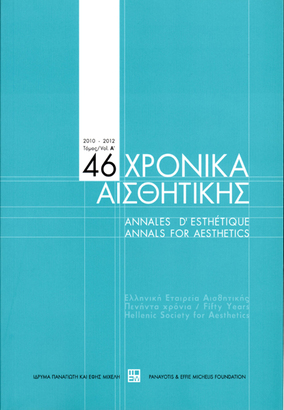Αναζητώντας την πολιτική διάσταση του έργου τέχνης στη μηχανική και ψηφιακή αναπαραγωγή του
Part of : Χρονικά αισθητικής : ετήσιον δελτίον της Ελληνικής Εταιρείας Αισθητικής ; Vol.45, 2009, pages 137-157
Issue:
Pages:
137-157
Parallel Title:
The quest for a political dimension of the work of art in the age of mechanical and digital reproduction
Author:
Abstract:
According to Walter Benjamin’s claim the political substance of art may be more technical than content-based.In this paper, my aim is to contribute to this reflection by analyzing first, the way that computer interface constitutes and structures aesthetic experience, and secondly, by questing for a political view in digital art, characterized as autonomous art.My point of departure will be Walter Benjamin’s The Work of Art in the Age of Mechanical Reproduction. In this epic essay he investigates how the mechanical reproduction transforms the work of art, claiming that in this ontological transformation the cult value, once characterizing the classical, aural work of art, has been replaced by exhibition value. In Benjamin’s view, exhibition value becomes the dominant principle in art, in which mechanical reproduction possesses a central role. In his essay he focuses especially on politics, emphasizing the relation between the work of art as product of mechanical reproduction with its cult value. It is obvious that Benjamin does not necessarily insist that art must maintain political engagement.Unfolding our research, since we are referring to the digital art, we may claim that after the ’50s, occurs a restoration of the ideas of 20th century avant-garde. The work of Duchamps, for instance, is always found in the practical view of the digital art. At the end of last century, after the '80s, many artists have renewed their work due to the influence of the new technologies (Nancy Burson, Lillian Schwartz etc.). But we consider more important our reference to two installations named W4 and Mega Mona Lisa (as extracts of Jos de Mul article titled “The Work of Art in the Age of Digital Manipulation”). They are brilliant examples of human-computer interface design, and an autonomous work of art on account of their new value emerged from the database recombination, which Jos de Mul named manipulation value.Finally, the political view within digital art can be found whenever these works of art challenge their recipient by directing his or her attention to the medium itself. These works of art are self-reflective media. We conclude by pointing out their political aspect, since they make us aware of the politics of their representation.
Subject:
Subject (LC):
Keywords:
ψηφιακά μέσα
Notes:
Η διάλεξη πραγματοποιήθηκε στις 19 Ιανουαρίου 2009, Περιέχει εικόνες




